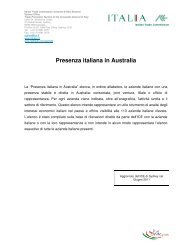Price Determination in the Australian Food Industry A Report
Price Determination in the Australian Food Industry A Report
Price Determination in the Australian Food Industry A Report
Create successful ePaper yourself
Turn your PDF publications into a flip-book with our unique Google optimized e-Paper software.
In addition to imports of crude or ref<strong>in</strong>ed oils which are fur<strong>the</strong>r processed <strong>in</strong> Australia, <strong>the</strong>re are<br />
imports of f<strong>in</strong>ished products which have a significant impact on <strong>the</strong> retail market and prices.<br />
Figure 86. Oilseeds: Major drivers of prices and costs<br />
1. Farm production factors<br />
• Can be significant volatility <strong>in</strong><br />
production which affects price and<br />
quality – oil content can range from<br />
36–48% which effects <strong>the</strong><br />
profitability of crush<strong>in</strong>g.<br />
• Production variation greater for<br />
summer-grown oilseeds.<br />
2. Value-cha<strong>in</strong> <strong>in</strong>tegration<br />
• High level of <strong>in</strong>tegration from<br />
farmgate to consumer, with high<br />
levels of concentration at primary<br />
and secondary process<strong>in</strong>g and<br />
retail.<br />
• <strong>Industry</strong> is characterised by very<br />
low economies of scale, <strong>in</strong><br />
particular compared with<br />
<strong>in</strong>ternational competitors, and<br />
this has significant impact on <strong>the</strong><br />
cost base.<br />
• The ability to expand <strong>the</strong><br />
crush<strong>in</strong>g sector is constra<strong>in</strong>ed by<br />
domestic demand for oil and lack<br />
of competitiveness <strong>in</strong><br />
<strong>in</strong>ternational markets.<br />
3. The market<strong>in</strong>g approach<br />
• There is a high brand presence<br />
with two of <strong>the</strong> largest<br />
consumer food companies<br />
<strong>in</strong>volved <strong>in</strong> <strong>the</strong> market<strong>in</strong>g of<br />
oils and fats – Goodman<br />
Fielder and Unilever.<br />
• There has been <strong>in</strong>creas<strong>in</strong>g<br />
differentiation of products<br />
<strong>in</strong>itially around poly and<br />
monounsaturated oils and<br />
seed type but <strong>in</strong>creas<strong>in</strong>gly on<br />
special health properties, for<br />
example, plant sterols.<br />
• The market is one <strong>in</strong> decl<strong>in</strong>e at<br />
<strong>the</strong> retail level and thus <strong>the</strong><br />
focus has been on brands and<br />
product differentiation to lift<br />
marg<strong>in</strong>s.<br />
Export market<strong>in</strong>g<br />
Farm production<br />
Crush<strong>in</strong>g<br />
Ref<strong>in</strong><strong>in</strong>g and<br />
packag<strong>in</strong>g<br />
Market<strong>in</strong>g<br />
Distribution<br />
Wholesal<strong>in</strong>g<br />
Retail<br />
<strong>Food</strong> service<br />
4. Regulation and compliance<br />
• There are no major regulatory<br />
issues. There are still s<strong>in</strong>gle<br />
desk arrangements <strong>in</strong> place <strong>in</strong><br />
New South Wales and Western<br />
Australia for canola but this<br />
does not have a significant<br />
impact on <strong>the</strong> <strong>in</strong>dustry.<br />
• As many of <strong>the</strong> plants <strong>in</strong> <strong>the</strong><br />
<strong>in</strong>dustry are old, <strong>the</strong>y tend to<br />
be located <strong>in</strong> or close to<br />
metropolitan areas and thus,<br />
environmental compliance is<br />
an ongo<strong>in</strong>g issue.<br />
• Increas<strong>in</strong>gly food safety is an<br />
important issue and most<br />
plants would have a hazard<br />
analysis critical control path<br />
(HACCP) and/or ISO<br />
accreditation.<br />
• A key issue fac<strong>in</strong>g <strong>the</strong> <strong>in</strong>dustry<br />
at present is <strong>the</strong> potential<br />
<strong>in</strong>troduction of genetically<br />
modified canola. This could<br />
potentially <strong>in</strong>crease <strong>the</strong> cost<br />
base of <strong>the</strong> <strong>in</strong>dustry if<br />
segregation for genetically<br />
modified and non-genetically<br />
modified is required.<br />
5. Trade impacts<br />
• The <strong>in</strong>fluence of exports is<br />
significant <strong>in</strong> canola and<br />
cottonseed but sunflower oil is<br />
regularly imported to fulfil<br />
requirements.<br />
• High levels of imports of palm<br />
oil for <strong>the</strong> low-cost end of <strong>the</strong><br />
<strong>in</strong>dustrial market and olive oil at<br />
<strong>the</strong> high end of <strong>the</strong> retail market.<br />
• The <strong>in</strong>fluence of imports of<br />
f<strong>in</strong>ished products from<br />
develop<strong>in</strong>g countries has a<br />
significant impact on retail<br />
prices <strong>in</strong> Australia and <strong>the</strong><br />
subsequent profitability of local<br />
processors.<br />
6. Technology and <strong>in</strong>novation<br />
• The crush<strong>in</strong>g <strong>in</strong>dustry is<br />
characterised by old technology<br />
with <strong>in</strong>efficiencies occurr<strong>in</strong>g <strong>in</strong><br />
equipment operation and<br />
configuration. <strong>Australian</strong> plants<br />
have a high labour ratio<br />
compared to large overseas<br />
plants.<br />
• There has been one new<br />
greenfield crush site developed<br />
<strong>in</strong> recent years which is state-of<strong>the</strong>-art<br />
but still small-scale.<br />
• There has been a move to a<br />
more diverse product range to<br />
meet consumer needs and <strong>the</strong><br />
<strong>in</strong>dustry is likely to see fur<strong>the</strong>r<br />
development of specialised<br />
products, such as high oleic<br />
canola. This will require<br />
<strong>in</strong>vestment <strong>in</strong> segregation and<br />
identity preservation systems.<br />
7. Retail market dynamics<br />
• Private label products are<br />
a major part of <strong>the</strong> market<br />
(50% of <strong>the</strong> market for<br />
cook<strong>in</strong>g oil) and put<br />
downward pressure on<br />
prices.<br />
• Chang<strong>in</strong>g consumer<br />
patterns are hav<strong>in</strong>g a<br />
major impact on demand.<br />
Consumption of margar<strong>in</strong>e<br />
is decl<strong>in</strong><strong>in</strong>g as people<br />
substitute o<strong>the</strong>r sorts of<br />
spreads on sandwiches or<br />
go without.<br />
• The supermarkets<br />
demonstrate significant<br />
<strong>in</strong>fluence and <strong>in</strong> <strong>the</strong> case<br />
of cook<strong>in</strong>g oil use <strong>the</strong><br />
threat of imported<br />
f<strong>in</strong>ished product as a<br />
means of keep<strong>in</strong>g prices<br />
down.<br />
<strong>Price</strong> <strong>Determ<strong>in</strong>ation</strong> <strong>in</strong> <strong>the</strong> <strong>Australian</strong> <strong>Food</strong> <strong>Industry</strong> A <strong>Report</strong><br />
81







